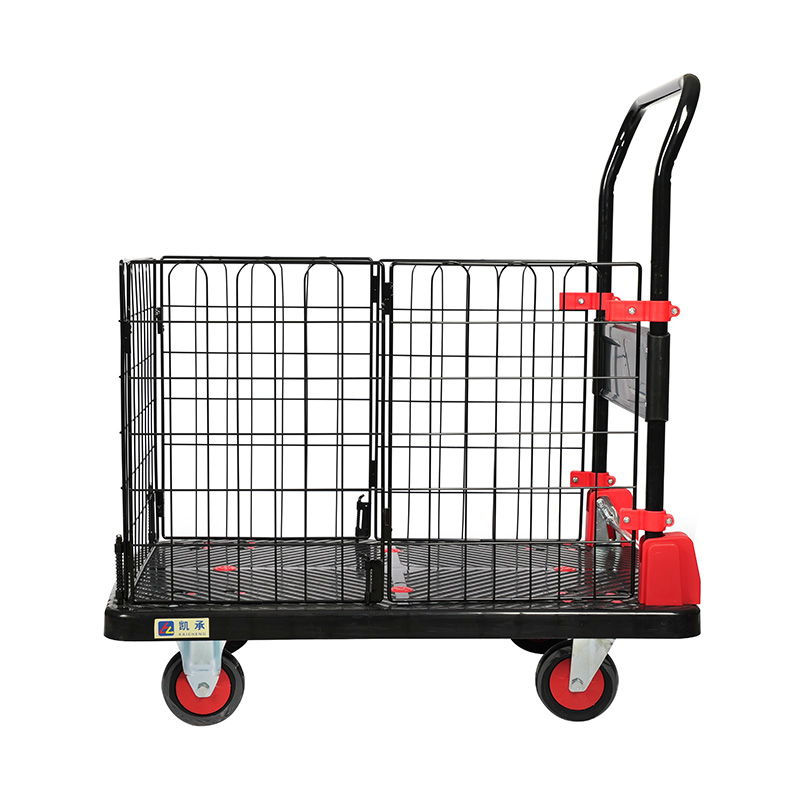The design structure of the Metal Foldable Trolley has a crucial impact on its load-bearing capacity and stability. With a reasonable design, the cart can carry a large weight without losing stability. Here are several key design factors that explain how they affect the load-bearing capacity and stability of the cart:
1. Frame material and material selection
Material strength and rigidity: The frame of the metal cart is usually made of steel, aluminum alloy, stainless steel and other materials. Steel and stainless steel have high strength and rigidity and can withstand large loads. Therefore, in the design of heavy-duty carts, steel or stainless steel is often used to increase the load-bearing capacity. Although aluminum alloy is lighter than steel, its strength balance is taken into consideration during design. It is often used in medium-loaded carts and has the advantage of being lightweight.
Alloys and plating: Some metal frames use special alloys (for example, magnesium alloy or aluminum alloy) to reduce weight while increasing load-bearing capacity. In addition, the metal surface is usually coated with an anti-corrosion coating (such as powder coating or spray coating) to prevent rust and corrosion, thereby extending the service life.
2. Frame design and support structure
X- or H-frame: The frame design of the cart directly affects its load-bearing capacity and stability. X-frame (cross-bracing) or H-frame (double-column design) can better distribute the load and avoid concentrated pressure causing frame deformation. The X-structure can improve the overall strength through cross-bracing, especially when the cart is carrying heavier items, to ensure that the weight is evenly distributed.
Strengthening support bars: Adding strengthening support bars to the key load-bearing parts of the cart (such as the frame, bottom support, connection points, etc.) can effectively enhance the frame's resistance to bending and deformation, and avoid structural damage to the cart under high load conditions.
3. Wheel design and distribution
Wheel quantity and size: The design of the wheel is a key factor affecting the stability and load-bearing capacity of the cart. Common cart designs have four wheels, two of which are swivel wheels and the other two are directional wheels. The larger the wheel size, the greater the load it can withstand, and it can also better adapt to uneven ground and improve stability.
Wheel material and load-bearing capacity: The wheel material (such as rubber, polyurethane, plastic, etc.) determines the friction coefficient and wear resistance of the wheel. Rubber wheels are usually suitable for use on uneven ground, which can provide better grip and reduce the possibility of the cart tilting. High-strength polyurethane wheels are suitable for carrying heavier objects because they have strong compression resistance, wear resistance and long service life.

Wheel position and distribution: The distribution of the wheels has a direct impact on the stability of the cart. If the wheel design is too concentrated, it may cause uneven load-bearing and affect the stability of the cart. Reasonable wheel distribution (such as symmetrical distribution of the four corners or bottom of the wheel) can ensure that the cart will not tilt or overturn when carrying items.
4. Handlebar and handle design
Reinforced handlebar: The design of the handlebar not only affects the controllability of the cart, but also directly affects the stability of the cart. The use of reinforced metal handlebars (such as thickened steel pipes or stainless steel pipes) can keep the cart stable when carrying heavier objects, avoiding bending or breaking of the handlebars due to excessive hand force.
Handle angle and length: The angle and length of the handle affect stability. The proper height and angle allow users to easily control the cart and avoid the cart from tilting or losing balance when pushing. A handle that is too long can easily cause the cart to tilt, while a handle that is too short may not be able to withstand a large load.
5. Folding mechanism and locking system
Folding and locking mechanism: Metal foldable carts are usually designed with a simple folding mechanism that can be easily stored and carried. However, the folding structure must take into account strength to avoid the cart from becoming unstable due to improper operation when folding or unfolding. High-quality folding carts are usually equipped with locking devices to ensure that the frame does not accidentally shrink when unfolding, ensuring safety and stability during use.
Weight distribution after folding: When the cart is folded, the change in the center of gravity will affect its stability. A well-designed folding cart can ensure that the weight is evenly distributed after folding, avoiding the cart from being too heavy on one side after folding, causing tilting or imbalance.
6. Chassis design and load balancing
Reinforced chassis: The chassis of the cart needs to bear the load, so the strength of the chassis is usually strengthened during design. The size and shape of the chassis also affect the load-bearing capacity. A wide and flat chassis can better distribute the weight and reduce the risk of structural damage caused by excessive local pressure.
Anti-slip design: The chassis and wheels are usually equipped with anti-slip design (such as rubber anti-slip pads or anti-slip coatings) to ensure that there will be no accidents due to sliding or imbalance during the cart process, especially when carrying heavy objects.
The design structure of the metal foldable cart is optimized through reasonable material selection, frame design, wheel configuration, handlebar design, folding mechanism and other aspects to ensure that it has sufficient strength and stability when bearing weight. By strengthening the chassis, using high-strength metal materials, reasonably distributing wheels and loads, and designing safe and reliable folding and locking mechanisms, the performance of the cart in different usage scenarios can be effectively improved to ensure safety and convenience during use.


 English
English Español
Español



